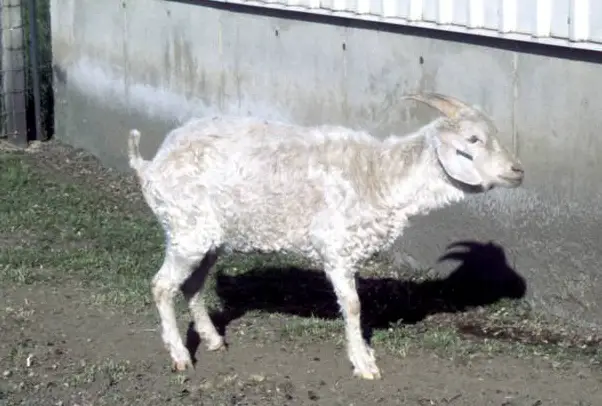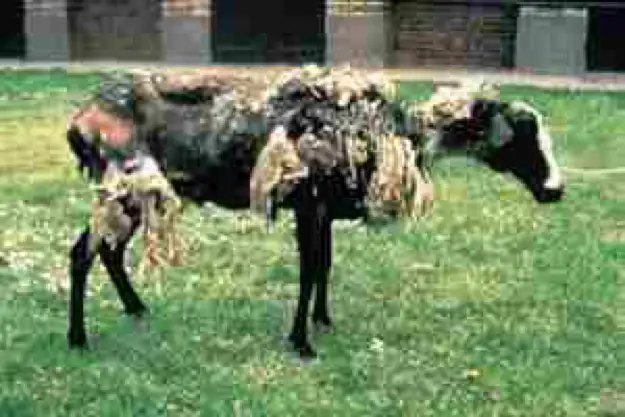Scrapie in sheep is a degenerative disease of sheep and goats caused by a prion protein. The disease is also called transmissible spongiform encephalopathies (TSE) and mainly affects the nervous system of sheep. The scrapie is not transmissible from humans to sheep.
The name of the disease scrapie is derived from one of the signs where the affected sheep continuously scrape their face against the rock, wood, or trees.
Importance of Transmissible Spongiform Encephalopathies (TSE)
Scrapie is a neurodegenerative and progressive disease in sheep and goats. The disease has been endemic in the United Kingdom since the 18th century. The disease is also found in other countries, including Australia and New Zealand. The disease was initially found in the Suffolk Punch sheep breeds but other sheep breeds.

Causes of Scrapie in Sheep
A prion causes transmissible Spongiform Encephalopathy (TSE) or scrapie. The prion is a modified protein molecule that can transmit diseases to living organisms. The prion is challenging to diagnose because it is smaller than the smallest virus and cannot affect by heat, radiation, or disinfectants. The prions multiply abnormally within the body cells, and the abnormal proteins accumulate in the nerve cells.
How do sheep get scrapie?
Transmissible spongiform encephalopathies (TSE) are transmitted by direct contact to lamb from infected ewe through ingestion of placental or allantoic fluid. The infected prion is also transmitted through the cut skin of the newborn lambs. The incubation period of the disease is 18 months to 5 years.

Pathogenesis of Ovine Scrapie
The organism enters through ingestion or cut skin and goes to the intestine. The prion then absorbs through the gut mucosa and enters the lymph nodes, especially the Payer’s patches of the small intestine. The organism (prion protein) travels to the brain through the spinal cord via the medulla oblongata.

Signs and Symptoms of Ovine Scrapie
The primary sign of the disease is changing the behavior of sheep. The most notable clinical signs are:
- Increased chewing movement.
- Ataxia.
- Excessive scratch against a tree, or wood, or wall.
- Loss of wool.
- Clinical signs of chronic diseases include anorexia, weight loss, weakness, lethargy, and death.
Diagnosis of Scrapie in Sheep
The disease is caused by prion protein, and the identification of prion in tissue is the final diagnosis for the disease.
- Specific clinical signs like scrapie, ataxia, and neurological signs.
- ELISA.
- Immunohistochemistry.
- Histopathology of brain tissue to diagnose the accumulated prion.
- Histopathology of lymphatic tissues and third eyelids.
Treatment of TSE in Sheep
There is no specific treatment available for scrapie. You can give palliative treatment to the affected sheep.
- Vitamin and minerals supplement.
- Nerve tonic like vitamin B1.
Prevention and Regulations of Scrapie in Sheep
The disease is emerging in the United Kingdom and must be reportable to the appropriate authority. The EU has passed a regulation that the disease is notifiable to authority. Though scrapie is related to animal health, the disease must be controlled and eradicated. The following measures can be taken:
- Proper disposal of affected sheep.
- Restriction on the use of bone meal of the affected sheep.
The critical aspect of prevention of TSE are as follows:
- TSE is transmitted through meat and bone meal that remains undetected.
- Scrapie in sheep remains unreported.
- Experimental Transmission of BSE found in sheep.
- Risk materials may not be controlled strictly for human health.
Concluding Remarks on TSE in Sheep
Scrapie is an emerging disease in sheep and goats. The disease is caused by a prion protein molecule and affects mainly the brain and central nervous system. The disease causes nervous signs, ataxia, scrapie, and general signs like weakness, lethargy, anorexia, and death. The disease has no treatment. The affected animal, after diagnosis, must be reported to authorities and destroyed properly.